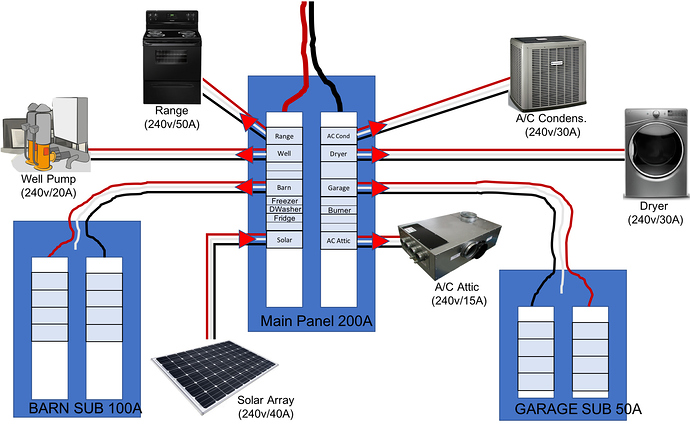No issues having an electrician do the work, yet I have also bee in my panel quite a bit (mains off) and previously ran some of my own circuits. Each of the devices I have listed are the actual circuit breaker rating on the listed items. Would you recommend using something that does not requite the removal of the wires. I was not sure if the main differences between the two models apart from solid core and not.
The Garage sub panel is a 50A where the previous owner did some auto repair work and had an electric heater; now removed. The only thing fed from the panel today apart from outlets are two garage doors (1/2 HP) and a mini-split A/C for the lower part of the house. This is a single run like a range, so it sounds like for anything that is 240v I would need to either double the connectors or join them as you suggest to have a single sensor pickup for both.
The Barn sub panel was a new install when we had our barn remodeled and they pulled 100A circuit for lighting, some networking gear and security cameras (POE), yet in the winter we do have to run two heated water buckets which I think will pull some extra Amps (but I’m sure a 50A would have supplied our needs. 100A may be just a safer option for a new install. I agree, I will need to add a 100A for the other side of the barn to make things easier.
You are correct on the “furnace” as it really is an oil burner for both the boiler and one for the Hot Water. So the current is only needed to get it started things started. I will have to go back and though through the 240V is this could impact the number of devices or CTs now. Thanks for checking.
Looks like the following would be 240V in my configuration: Range, Clothes Dryer, Barn, and Garage. I may do the turn around option for these so I can have more sensors then less. Nothing else I can think of is 240V. Is a typical Solar install 240v I would have to assume?
Lastly (I think), I assume you can combine two lower amp circuits that are really the same device such as the A/C unit which has a 15A for the blower in the Attic and a 30A for the outside condenser. If I put a single CT around them, we could be able to bind the used current for the one device, correct?
Looking more like this may be a better option and give me flexibility:
Here are a few images for my panel at 240V items and an image/question on twisting one leg of the cable around in the CT.
When you say turn around one of the wires in a 240v circuit (sub panels, dryer, AC) do you mean like the below? Do you not get both negative and positive values in the configuration? Maybe I’m missing something as I thought they were directional sensors and such a configuration would show positive current for one flow and negative current on the other leg.
Is the reason you cannot do the below is that you only get 1/2 the current measured do to the 120v reference current?



